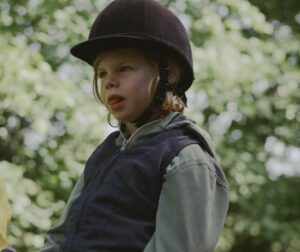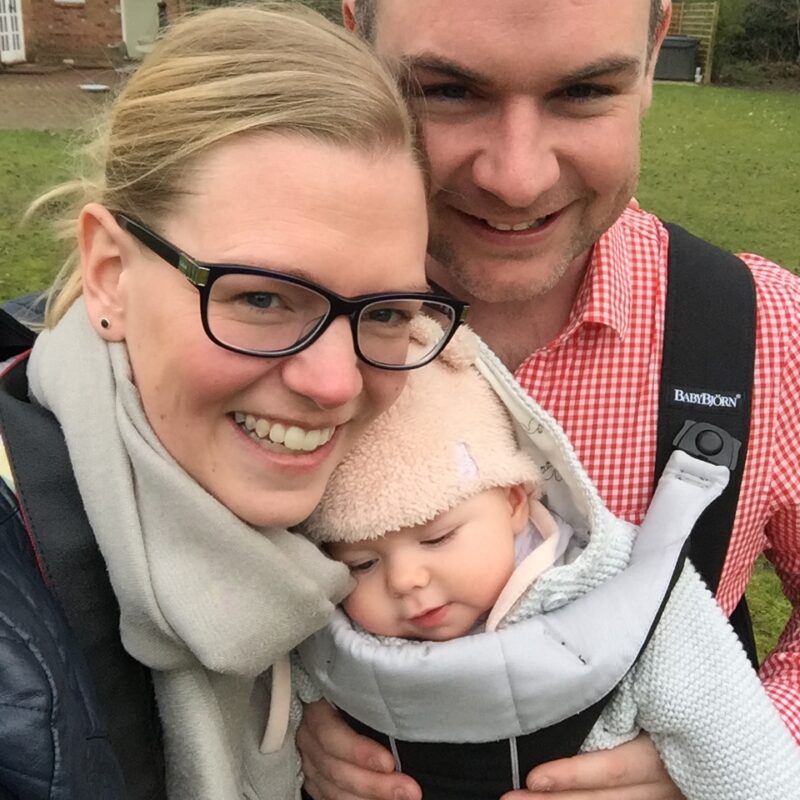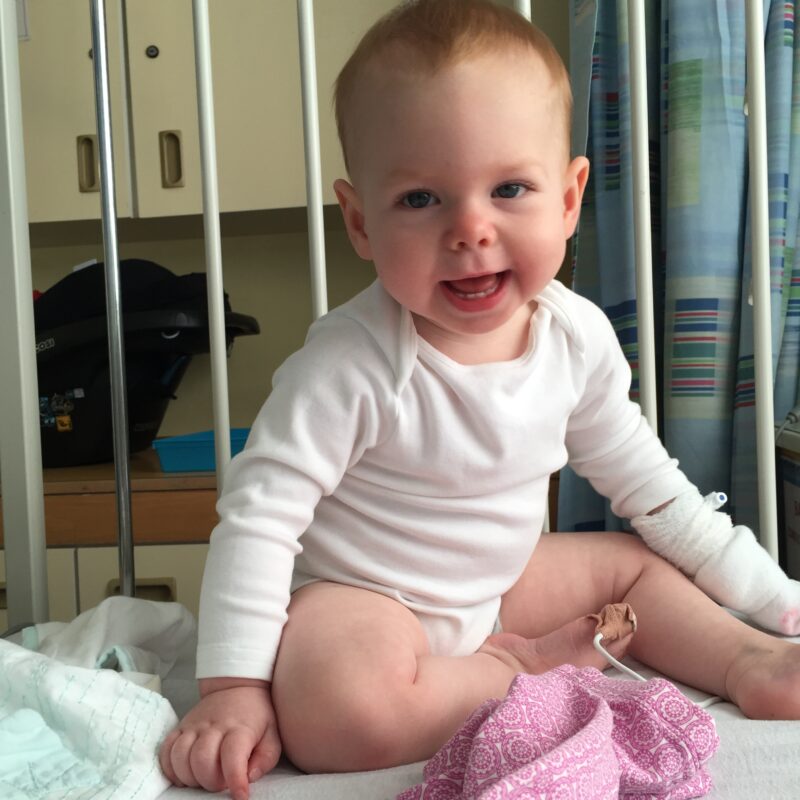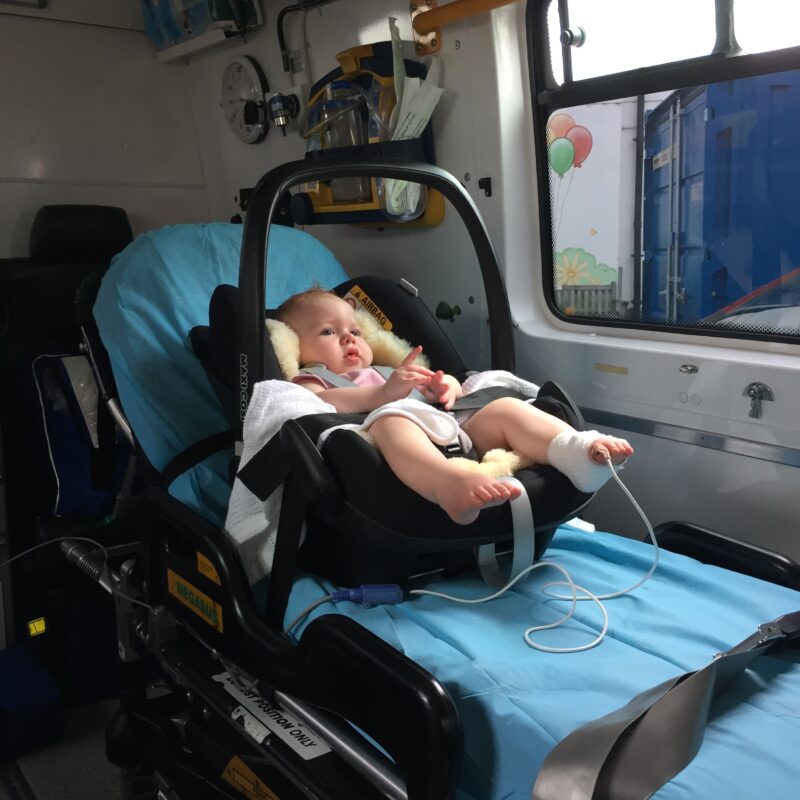First Presentation
It was the 19th November 2015 at 7am in the morning, I had just finished breast feeding Beth. She was seven weeks old, I swaddled her up after giving her a cuddle, and I noticed her arms moving and my first thought was ‘oh, I’ve swaddled you tight!’, because you know when you get a trapped nerve, that’s what it looked like. I had never seen a seizure in my life before that point.
I put her on the bed and opened up the swaddled blanket and obviously I know now that it was a tonic clonic seizure, everything was going, and in that moment, I screamed at the top of my voice ‘TOM!!!!’ And my husband actually has almost like PTSD from that shout. He wakes up in the night thinking I’m calling because he says it was such a blood curdling scream.
He raced in, and we were obviously both like ’what is going on?!’ and I don’t know why, but while I was calling an ambulance I said to him ‘video this’ because I’d never seen anything like it and I thought we had to show someone what had happened.
The paramedics were with us within three minutes, and blue lighted us to the hospital. They did blood tests, CT scans, lumbar punctures, MRIs, every single test she could have, they did. She’d stopped seizing so it was almost as though nothing had happened. Fortunately, because we’d videoed it, they could watch the seizure.
We were in hospital for a week because Beth was so young. But they reassured us that she was fine, she’s well and said: ‘go home and enjoy your baby’. And almost forget that this has happened. We went home and tried to forget about it.
Ten days later it happened again. And this time it was the middle of the day, and I was in the shower. I had a friend staying and she came bombing into the bathroom. I was absolutely traumatised. We were blue lighted again to the hospital, and that day she had four seizures with the doctors and nurses there and the next day she had six. So, we were in hospital for a very long time.
They redid all the tests, the lumbar puncture, they redid everything and by this point Beth was having multiple seizures, and they started her on an epilepsy medication, which was actually the worst medication for Dravet, but obviously at this point they didn’t know she had Dravet.
Gaining a diagnosis
We were there for a number of weeks, and I remember a doctor saying there’s one more test they could do, some genetic testing, they checked our medical records and meanwhile we were asking our family, and extended family, you go through all those motions.
The genetic tests take some time, so that was the end of November, and we got Beth’s diagnosis of Dravet Syndrome on the 14th February the following year. Just as we walked into the consultant’s room, Beth had a massive seizure, so we dealt with that and then while she was having a sleep, and I won’t ever forget the moment, the doctor said: ‘so we now know why Beth has her seizures.’
Initially, in fact for years, he didn’t use the words ‘Dravet Syndrome’, he said: ‘she has a genetic mutation called SCN1A’ and I said to him ‘that’s Dravet’ because by this point, like all parents, I had done my research.
She was only having seizures when we were bathing her, changing temperature, when I took her nappy off, when I underdressed her, she had a seizure, so that change in temperature for Beth was absolutely huge.
He explained that Beth had this mutation and there were different drugs we could try. He explained that it may not be controllable. Instantly I felt relief, because I thought ‘finally we know’, because in those three months Tom and I had sent ourselves a bit doolally. I was always sitting in a dark room because I was convinced that the light shining through the curtains would give her a seizure, because sometimes she would look at the light and have a seizure.
I wasn’t leaving the house, I was terrified because I’d just be undressing my baby, and she’d have a seizure. When I look back at that now, you do almost feel like you are sending yourself a bit mad because you are so focussed on finding out the reason why.
Early years after diagnosis
For the first year of Beth’s life, I slept in hospital more than my own bed. So that kind of shows how Dravet affects you, when they are younger. Whenever I end up back in hospital I do feel like a bit of PTSD sets in when I’m in the back of that ambulance or at the hospital. Because you just think ‘I can’t go back to living here’ again.’
The frequency of her seizures when she was little was huge. I used to write them down, but there were so many that it got a point when I stopped writing them down. She had literally hundreds of seizures of all different types and they were long. Her longest seizure was 98 minutes. She has been intubated twice. A lot of Beth’s seizures lasted over an hour. They aren’t five or ten minutes, they are horrific, traumatic to see. I felt like I’d lost her so many times.
I think that’s the most terrifying part about the condition, you don’t know when a seizure starts, you’ve got absolutely no idea, whether it is going to last, a few seconds or 98 minutes, you just don’t know. You don’t know when it’s going to start, you don’t know when it’s going to end, she could be having one right now at school, and you don’t know whether that is the end and that’s really horrible as well because Dravet has such an enormous spectrum and you have children who are in mainstream school who are talking and walking, living a relatively typical life, and then you’ve got children at the other end of the spectrum who can’t talk and can’t walk.
Life Today
We were told that Beth wouldn’t walk, but she can, but not very steadily. Her mobility is also going, and she is spending a lot of time in her wheelchair at the moment. She is non-verbal and she has autism, and behaviours that challenge.
She has got no preferred communication method, so she doesn’t suit Makaton or cards. We use short spoken language, but we have no idea if she is understanding it. We have an incredibly rigid structure to her life, because that’s what she needs.
Non school days are very challenging. Regardless of what time she gets home, its food time. I have a four year old as well, but I still can’t be alone with both of my children at the same time. It’s just not possible. It’s helicopter parenting with Beth, you have to be behind her all the time, you can’t leave her for a second as she has no awareness of dangers. So, it’s incredibly difficult.
She goes to a wonderful, local special needs school and she is gradually building up her time there.
Nearly ten years on and the frequency of Beth’s seizures has massively reduced. We started a new drug two years ago. We had some awful tonic clonic seizures last November, but at the moment we are just seeing short absence seizures of 30 seconds. That drug for us has been a real gamechanger, but it’s flipped at the same time with her behaviour being more challenging. I don’t know if that’s the drug, or whether that’s just her age, but she’s bigger, she’s stronger, she’s very determined.
And we are seeing the absence seizures creep up and up and up. She has a sleep disorder, she has never slept through the night, and suddenly she had these two weeks where she was having all these absences.
So, while she has not been in hospital for a while, it’s still Dravet and it keeps changing and there are other challenges.
Photos of Beth and her family
The impact of caring for a child with Dravet Syndrome
Before I had Beth I worked for a bank as Head of HR. I’d worked really hard to get where I was. I went on maternity leave, fully planning to go back. They were the most supportive organisation ever. They were supportive all through maternity leave. I was given a career break, no questions, for another year. But I said, ‘I can’t come back, I won’t be any use to you’, I’m in the back of ambulances weerkly still’. They said I could work from home, or part time, ‘we want you, back, what can we do to help?’
But I just knew I couldn’t. So, I had to walk away from my career, which at times is still hard because I loved my job. And I love my job now, but its very different. Sometimes I wonder where I would have been, what would I have done if things were different. It was a hard decision and also an easy decision. It just wasn’t possible to go back at all.
Life is very different to how I imagined it. I think you become very resilient, and certainly my mum is incredible, I don’t know what I’d do without her.
She says that she has observed that in an emergency situation that I step back a little bit and become a bit military, but nice. I take charge, the way I speak to the crew, I explain this is what’s happening, and all the ambulance crews have been very complimentary and say it’s usual to come into a house and all of the documents are there ready to handover to them. I’ve got care plans written, I tell them what I’ve done, and this is what we need to do. They ‘ve said ‘you’re so in control’, and that often they go into this kind of situation, and they spend time having to calm the families down.
And even when Beth has been blue and I’ve almost had to resuscitate her, they come in and they say, ‘your ability to transcribe what has happened so they are fully up to speed and can take over is remarkable.’ So, I’ve changed, I’ve had to change.
I’ve worked in stressful situations, and I used to say to my team ‘you need to organise the chaos. It can be chaotic, but you need to organise the chaos’ and that’s exactly what my husband says I’ve done. Seizure chaos. Organise it.
We’ve got a hospital bag packed, we’ve got all of this done. It’s my control mechanism. What I can do to try and control the situation I will do. Anything I can do to make it as simple and as practical as possible I will do.
When things calm after the emergency scenario, I always feel like its two weeks later weirdly, my body seems to have chosen that, I suffer from get psoriasis which I get when I’m really stressed. It’s always about two weeks to the day afterwards that I get it on my face and I get it in my eyes, which is horrible. It’s almost like my body’s way of saying enough, it’s that reaction.
It puts an enormous strain on a marriage, huge, life is very different to how you expected it. Those stressful situations are very difficult and very hard. In order for us to have a second child, my husband took a career break, so he was home for a couple of years because I couldn’t have had a newborn with Beth.
I had Grace in June 2020 and of course then the world went into lockdown in March 2020. So, I had a clinically vulnerable child and a newborn baby, and Beth’s seizures started coming back, so we were to and fro to the hospital again, which was not where you wanted to be when COVID was there.
Thankfully after a bad spell at the start of COVID, we managed to then stay out of hospital through the rest of the pandemic.
The need for support for parents
I think for a long time I didn’t want to have any take any help, I was like I’m fine, but my friends and family were like ‘you need to be talking to somebody’.
We’re under Shooting Stars children’s hospice and so before they had to close one of their sites, we had some respite stays there. I never left Beth there, but at least I could stay in the parent room upstairs. And we went there to use their hydrotherapy pool, and I had some counselling through them twice.
And I had some counselling before Grace was born because I was really worried about Grace being seven weeks old, I just couldn’t get it out of my head. I was really worried that I wasn’t going to enjoy Grace and that I’d be looking at this seven week old baby and thinking this is when it all started with Beth. I just wanted to talk to someone about that and to get some coping mechanisms around that.
I have been depressed at times, definitely. Never clinically diagnosed but I don’t know anyone that couldn’t not be depressed in this life.
Beth doesn’t sleep so my husband and I do a night on, a night off. So, if you’ve got Beth for that night, you’ve got all her monitors and alarms, everything. Beth wakes up two or three times a night, and it can be for an hour or two hours. She’s in a safe bed and she’s very happy but she’s awake and obviously that’s crucial seizure time because she’s tired but awake. So, it is exhausting, absolutely on your knees exhausting. So, I sleep in my own bed every other night, that’s become my norm. And, of course, in between this we’ve also Grace, so we’re up and down.
Tom stopped working for two years to enable us to have Grace. We agreed to take that hit because it’s something we want to do. Now he’s back at work. He says: ‘you go back to work; I’ll stay at home’. I have an incredibly supportive husband, but I would never want to go back and do what I did now. So, while I miss it, I would want to work in a different field now.
But I can’t cope yet, my heads not there, it’s a full time job looking after Beth. And I don’t feel like I’m over the trauma of it all enough.
PTSD is definitely something I have suffered, one hundred percent. A while ago, over a period of ten days, I was in ambulances with Beth being blue lighted to hospital four times. And we’d had this spell of not being in them. And her consultant walked in, and I said ‘I can’t do this anymore, I cannot go back to being here. I almost felt like I was rocking.
Suddenly looking at this child, who is just getting bigger, and when Beth wakes up she’s bigger, she’s postictal, she’s got no awareness of danger when she’s alert, so when she is in the hospital bed, as soon as she has come round, I have to put her in her wheelchair because she isn’t safe otherwise and I’m not strong enough to keep her on the bed.
Just being constantly on, on high alert is absolutely exhausting.
Seeking support
I chose to get my counselling through Shooting Stars Hospice because we are fortunate to have a hospice near us. But that’s rare.
I was offered counselling through the GP, but they don’t know what it’s like to have a child with a complex condition. They don’t know have that understanding. There needs to be greater access to support for parents.
Counselling, or some kind of support, such as access to groups, access to other people who ‘get it’. And that sounds so simple, but the thought of me having to go and explain what Dravet Syndrome is and what Beth does on a day to day basis, that is exhausting in itself. I just want to talk to someone who understands what it’s like to look after a child with complex needs.
And what I was offered on the NHS, was absolutely not appropriate, for someone in my position. I was very frustrated because when I asked my GP for help, the first thing they did was offer anti- depressants. I felt quite angry. It wasn’t what I wanted. It’s not that I’m against them, but I wanted to have a conversation.
Support from DSUK
As a family, we’ve discovered a fantastic number of resources through Dravet Syndrome UK—both via their website and their social media accounts. The Dravet Syndrome UK Family Guide has proved absolutely invaluable for us in getting to grips with what a new Dravet Syndrome diagnosis means, and in helping us educate friends, family, and professionals involved in our daughter’s care.
It’s a scary diagnosis to receive, but the charity is wonderful – they really offer a personal touch. Every member of staff we’ve interacted with genuinely cares, and you can feel that at their annual conferences. Those conferences are such a great opportunity to meet other families and medical professionals who are going through similar experiences. The level of expertise in the room is mind-blowing; you’re so lucky to have access to worldwide experts, who are happy to engage in any conversation with you throughout the day.
On the back of that, you make great connections with other family members. The social media group is an incredible support network, too. Unless you’re living with this condition, it’s hard to fully understand what it’s like, but other mums, dads, and carers share advice about medication, milestones, equipment, and so many day-to-day challenges. You feel so supported by the community.





